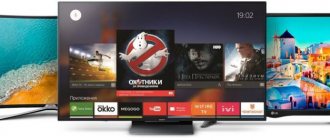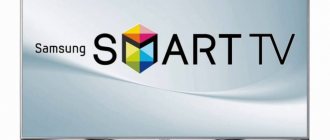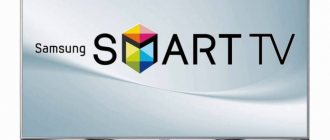The Smart TV function on TVs from the Korean company LG appeared almost simultaneously with its introduction by its main competitor, the Korean giant Samsung. At the moment, in terms of its level of development, these two “Koreans” share this niche, and meanwhile the technology is becoming more and more popular. We dedicate this post to connecting LG TVs to the Internet via cable or WiFi and setting up such a wonderful feature as Smart TV. We will also look at how to take advantage of all the benefits of this technology.
Connecting a tuner
To provide a TV with Smart TV capabilities, a so-called module (TV Box, set-top box, tuner) for Smart TV is connected to it. Since such a TV-Box fully replaces: WebOS, applications for watching TV channels on Internet television. IP-TV can be configured either standard or specially downloaded.
Pairing the TV and tuner itself is simple - use any cable to output picture and sound, connect two devices. This could be HDMI, VGA, RCA (tulips) and so on.
An overview of popular models can be found here.
Features of the model range
LG is expanding its line of OLED TVs in 2021. The line consists of the BX, CX, GX, WX, ZX and RX series.
The company is including a 48-inch OLED model (CX series) and a 77-inch 8K OLED for the first time. The E series has been discontinued in favor of the new GX "Gallery" model, which is designed for wall mounting. The company has also updated the soundbar for the WX OLED wallpaper.
The BX series is equipped with the third-generation Alpha 7 processor, while other models are equipped with the more powerful third-generation Alpha 9. Most other features are shared across OLED models, with a few exceptions. All of them have 4K resolution (except ZX). They all have HDMI 2.1 ports, as well as additional features such as VRR (except WX and RX), ALLM and eARC. All of them are equipped with Dolby Vision IQ, Filmmaker mode and support for three HDR formats (HDR10, HLG and Dolby Vision).
HDMI 2.1 support sets LG OLED TVs apart from competing OLED TVs. It was surprising to see LG implementing HDMI 2.1 in its 2021 models, but it's even more surprising to see its competitors reserving HDMI 2.1 primarily for 8K TVs in 2021. Considering that Sony and Microsoft are planning to release next generation game consoles with HDMI 2.1 (for 4K120, 8K) this year.
LG 2021 OLED TVs also support HDMI 2.1 VRR, FreeSync (via a later firmware update) and "G-Sync Compatible".
In 2021, the South Korean company introduced the world's first rollable TV. After lengthy delays, it is expected to arrive later this year as a 65-inch RX OLED for €60,000. This is completely out of reach for any normal person, but this technology could eventually make its way to more affordable TVs.
Also out of reach for any average person are LG's 8K OLED TVs. The company will add a smaller 77-inch 8K OLED model to its lineup, and it will remain too expensive.
LG introduces an updated line of NanoCell LCD TVs with 8K or 4K resolution. Some of these LCD models have a FALD (Full Backlight Local Dimming) feature. The number of zones hasn't been increased compared to last year's models, but LG says the improved FALD settings have improved brightness control.
You can also expect the appearance of new 4K LCD TVs in the UN8x and UN7x mid-range series. For the first time, LG will not have new Full HD or HD Ready models in 2021. 4K now represents the mainstream and budget segments as LG has begun its transition to 8K.
If you're looking for excellent HDR picture quality, you should look at OLED models. For HDR, contrast is king and it is critical that contrast can be controlled at every point, preferably at the pixel level. Self-emissive display technologies such as OLED and microLED have millions of pixels, each emitting and controlling its own light.
This year, LG introduced improved dynamic tone mapping for HDR, as well as an HGiG mode to more accurately represent console games in HDR. LG is dropping support for Technicolor's Advanced HDR format, but that's hardly a loss considering that several years later there is virtually no content available in Advanced HDR in the consumer market.
The latest version of webOS (version 5.0) includes new features such as universal search and recommendations, 'Sports alert', redesigned Home control panel and various other tweaks. As usual, version 5.0 of webOS will be reserved for 2021 models. Previous models will not be updated.
Some of the models will have voice control without gestures (GX and above) via an always-on microphone. Other models come with a remote control with a built-in microphone that can be activated with the press of a button. The TVs support Google Assistant and Amazon Alexa.
2020 LG 8K TVs support AV1 hardware decoding, the company announced. AV1 is a new video codec format developed by the Alliance for Open Media, which includes Amazon, Apple, Facebook, Google, Netflix, IBM, Intel, Microsoft and Mozilla. YouTube 8K streaming requires AV1 support on 8K TVs.
LG 2021 TVs also come with support for Apple TV apps, AirPlay 2, and HomeKit. The Apple TV app gives you access to iTunes movies and Apple TV+ content in up to 4K Dolby Vision (Atmos coming in a later update), and AirPlay 2 lets you wirelessly stream videos, music, and photos from your iOS or macOS device to your TV. HomeKit allows you to integrate your LG TV into your connected home system. Additionally, it allows you to control certain aspects of the TV through the Remote app for iPhone/iPad.
Dolby Atmos audio support allows you to output Dolby Atmos via HDMI eARC or ARC to your soundbar or speaker system. Built-in TV speakers can also output Dolby Atmos, but with severe limitations due to the nature of compact built-in TV speakers. "Wallpaper" WX come with a more powerful soundbar.
The TVs also have built-in Wi-Fi 5(ac) and, for the first time, Bluetooth 5.0.
You can distinguish LG 2021 OLED TVs from models of previous years by the letter “X” (X as 10) in the model name (for example CX):
- X = 2020
- 9 = 2019
- 8 = 2018
- 7 = 2017
- 6 = 2016
New LCD models are designated "Nano" or "UN".
- Nano/UN = 2020
- SM/UM = 2019
- SK/UK = 2018
- SJ/UJ = 2017
- UH = 2016
- UF = 2015
- UB = 2014
Setting up IPTV on an LG TV
In Smart TV LG IPTV, the source of consumption of m3u playlists or specific channels is configured. Whether the channels will be paid or free depends on which source you will connect to. For example, a provider may provide a package of 150 channels for a certain amount, which is included in your tariff plan.
Otherwise, you can find free Internet TV on the Internet.
If a playlist is located on a remote server, then you need to provide a link to it in the appropriate section of the application you are using for IPTV on LG Smart. Set-top boxes in standard applications can limit the number of connected playlists. But usually 3-4 self-sorted lists are enough.
Step-by-step free setup of IPTV on TV-Box or Smart TV using a popular third-party client and source:
- Go to the app store and download the VLC application - it is a multifunctional player.
- Then, through any browser, enter “IPTV playlist from Github” in the search bar or follow the link:
https://github.com/iptv-org/iptv
- Copy the link to any playlist. Link to the main one, 8000+ channels:
https://iptv-org.github.io/iptv/index.m3u
- Open VLC and click on the “Broadcasts” or “Stream” section.
- Enter the URL in the line that appears and click “OK.”
- Then click on the playlist, wait for it to open and watch the channels for free online.
What's next?
LG TVs do not allow you to fully use the Smart TV function without registration. Therefore, in order to fully use it, for example, install various applications and widgets from Smart World, you need to register on the LG website. The process is not complicated, but if you are not at all confident in your abilities, it is better to ask someone who has a better understanding of technology to register yourself. To register you need to complete the following steps:
Go to the main menu using the Home button on the remote control. In the upper right corner, select Login.
Most likely you have not previously registered on LG Apps, so select “Registration”. If you have an account, then enter the data, click Login and proceed to the last step.
We pretend that we have read the user agreement, and then the privacy policy, and click agree










